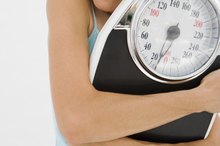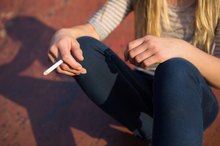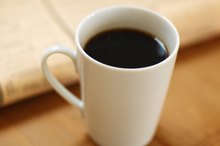What does fact checked mean?
At Healthfully, we strive to deliver objective content that is accurate and up-to-date. Our team periodically reviews articles in order to ensure content quality. The sources cited below consist of evidence from peer-reviewed journals, prominent medical organizations, academic associations, and government data.
- MayoClinic.com: Work-Life Balance: Tips to Reclaim Control
- PubMed.gov: Anxiety and Depression Are Associated with Unhealthy Lifestyle in Patients at Risk of Cardiovascular Disease
- PubMed.gov: Anxiety and Depression Are Associated with Unhealthy Lifestyle in Patients at Risk of Cardiovascular Disease
The information contained on this site is for informational purposes only, and should not be used as a substitute for the advice of a professional health care provider. Please check with the appropriate physician regarding health questions and concerns. Although we strive to deliver accurate and up-to-date information, no guarantee to that effect is made.
What Are the Causes of Anxiety From a Behavioral Perspective?
Anxiety is a physical manifestation of thoughts and fears about the ability to manage circumstances, according to the University of Maryland Medical Center. Although a certain amount of anxiety is normal, when fear and worry inhibit an individual from taking steps to resolve the issue, it is important to identify the cause of the anxious feelings and take action to remedy the situation or consider a change in behavior.
Work-Life Balance
Maintaining a healthy balance between work and personal life requires constant adjustment and is an ongoing process, according to MayoClinic.com 1. Time management--both at home and on the job--is a learned skill. Learning to ask for help, exercising the option to say no and taking time for personal development and self-nurture often make the difference between physical and mental health and burnout. The ability to adapt to stress fosters resilience and self esteem, two important mechanisms to avoid unnecessary anxiety, says psychiatrist and author Daniel Amen.
- Maintaining a healthy balance between work and personal life requires constant adjustment and is an ongoing process, according to MayoClinic.com 1.
- Learning to ask for help, exercising the option to say no and taking time for personal development and self-nurture often make the difference between physical and mental health and burnout.
Lifestyle Choices
Self Calming Techniques for Anxiety
Learn More
During times of stress, people often turn to unhealthy behaviors to alleviate anxiety. Negative thought patterns, a lack of exercise and consumption of empty calories often increase rather than diffuse anxious feelings and can contribute to ill health and depression. In a review of approximately 1,600 at-risk cardiovascular patients, researchers found a strong association between an unhealthy lifestyle and the degree of anxiety the patients experienced 2. The study appeared in the February 2005 issue of the journal “Atherosclerosis.”
- During times of stress, people often turn to unhealthy behaviors to alleviate anxiety.
- In a review of approximately 1,600 at-risk cardiovascular patients, researchers found a strong association between an unhealthy lifestyle and the degree of anxiety the patients experienced 2.
Unrealistic Goals and Expectations
High standards that are difficult to achieve are admirable, but may set a person up for unnecessary anxiety and feelings of failure. Circumstances do not cause stress, says author Andrew Berstein; rather, it is how people choose to interpret events in their lives that cause the anxiety. Psychologist Henrie Weisinger, the author of “The Genius of Instinct,” writes that people who learn to change the way they think about their problems rather than try to overcome their anxious feelings are more likely to live stress-free lives.
Related Articles
References
- MayoClinic.com: Work-Life Balance: Tips to Reclaim Control
- PubMed.gov: Anxiety and Depression Are Associated with Unhealthy Lifestyle in Patients at Risk of Cardiovascular Disease
- Bystritsky A, Khalsa SS, Cameron ME, Schiffman J. Current diagnosis and treatment of anxiety disorders. P T. 2013;38(1):30-57
- Gelenberg AJ. Psychiatric and Somatic Markers of Anxiety: Identification and Pharmacologic Treatment. Prim Care Companion J Clin Psychiatry. 2000;2(2):49–54. DOI:10.4088/pcc.v02n0204
- Taylor CB. Panic disorder. BMJ. 2006;332(7547):951-5. DOI: 10.1136/bmj.332.7547.951
- Grupe DW, Nitschke JB. Uncertainty and anticipation in anxiety: an integrated neurobiological and psychological perspective. Nat Rev Neurosci. 2013;14(7):488-501.doi: 10.1038/nrn3524
- Jerath R, Crawford MW, Barnes VA, Harden K. Self-regulation of breathing as a primary treatment for anxiety. Appl Psychophysiol Biofeedback. 2015;40(2):107-15. DOI: 10.1007/s10484-015-9279-8.
- Morrison AS, Heimberg RG. Attentional control mediates the effect of social anxiety on positive affect. J Anxiety Disord. 2013;27(1):56-67. DOI: 10.1016/j.janxdis.2012.10.002
Writer Bio
Susan Brassard writes about natural health-related topics, complementary and alternative medicine and issues relative to a holistic approach to the aging process. Following a career in business and finance, she obtained a Master of Arts in gerontology and several certifications in energy therapies. She is the author of a workbook and resource guide for older adults.









